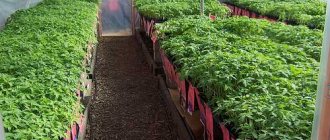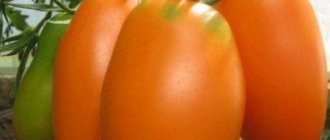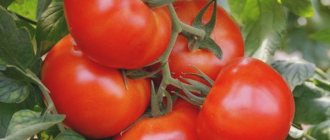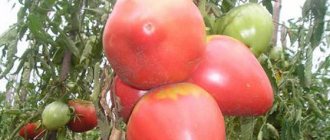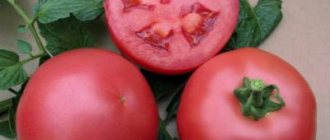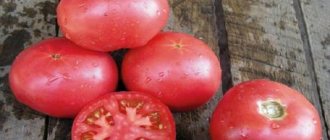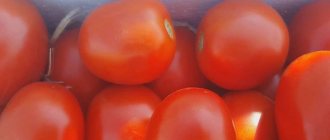Description of the tomato variety Ksenia f1, its characteristics and cultivation
The hybrid tomato Ksenia f1 was bred by Russian breeders for cultivation in open and closed ground. The variety has a number of features due to which it is often used by gardeners.
Characteristics of the variety
Early ripening determinate variety of tomatoes. From planting seeds for seedlings to receiving the first harvest, it takes from 82 to 100 days. To obtain an earlier harvest, tomatoes are grown using seedlings. Bush of medium climbing, low. An adult plant reaches 100 centimeters in length. The foliage is average. The variety does not require pinching. Up to six fruits ripen in one axil. The harvest is high - up to 18 kilograms of fruit are harvested per square meter.
Description of the tomato: rounded, flat, slightly ribbed. When ripe, a green spot does not appear on the stalk. The color is bright red. Ripe tomatoes grow up to 130–150 grams.
The pulp is fleshy and juicy. The taste of the variety is excellent - it has a sweetish taste with sourness. Intended for fresh consumption, production of tomato juice and canning.
Plants are resistant to tobacco mosaic virus, Alternaria blight, ChBP and temperature changes.
Positive qualities of the variety
The positive characteristics of the variety include:
- early harvest;
- high productivity;
- transportable qualities;
- resistance to fungi;
- excellent taste.
The Ksenia hybrid is often used for growing tomatoes for sale.
Agrotechnical features of cultivation
Before planting in the ground, seedlings are prepared at home. In March, seeds are sown in containers for germination, watered with warm water and covered with film. When the seeds hatch, the film is removed and the seedlings are placed in a sunny place for further growth. Ksyusha responds well to soil fertilized with organic matter, moderate watering and care.
It is advisable to plant seedlings in beds where garlic, carrots, dill, parsley, cucumbers or cauliflower grew last season. Scheme for planting plants in the garden bed: 50 by 40 centimeters.
Caring for tomato beds
In order to get an excellent harvest of ripe and healthy tomatoes in the future, you need to properly care for the plants.
- Watering plants.
- Weeding and loosening the beds.
- Gartering and thinning bushes.
- Identification of diseases.
- Feeding with minerals and organic matter.
During the entire growing process, the characteristics of the bush require garter. This is done so that the heavy brushes do not break off under the weight of the tomatoes, and the plant does not fall to the ground. Tomatoes are demanding when it comes to watering, fertilizing and weeding. After each irrigation, the soil must be loosened to retain moisture for a long time. During the season, the soil is fertilized at least three times.
Weeding is an important condition for growth; if there is a large amount of weeds, all the fertilizers will go into the weeds, leaving no food for the tomatoes. You also need to monitor the condition of the bushes and fruits. If a disease is detected, immediately take measures to destroy the virus or fungus.
Review of reviews about the variety
A review of reviews showed that the Ksenia f1 tomato is grown not only in Russia, but also in neighboring countries: Moldova, Ukraine. And there he also showed excellent results.
Olga Pavlovna writes: “I planted the Ksenia hybrid last year, and it surprised me with a bountiful harvest and early ripeness of the fruits. When cultivated in an open garden bed, the variety resisted late blight and other equally dangerous diseases. The bushes have not grown. I only picked off the lower leaves for better ripening. Now I recommend this variety to all my friends.”
As you can see, with proper care, tomatoes cope well with diseases, produce high yields and grow in open areas and in greenhouses.
Agrotechnical features of cultivation
Before planting in the ground, seedlings are prepared at home. In March, seeds are sown in containers for germination, watered with warm water and covered with film. When the seeds hatch, the film is removed and the seedlings are placed in a sunny place for further growth. Ksyusha responds well to soil fertilized with organic matter, moderate watering and care.
It is advisable to plant seedlings in beds where garlic, carrots, dill, parsley, cucumbers or cauliflower grew last season. Scheme for planting plants in the garden bed: 50 by 40 centimeters.
Interesting on the topic:
Garden beds according to Kurdyumov: how to work less and get excellent...
Mar 3, 2022
Important rules for feeding roses that help me...
Mar 3, 2022
Description of the ultra-early hybrid tomato Ksenia and growing tips
Tomato Ksenia F1 is an ultra-early hybrid. The first tomatoes are harvested 3 months after planting the seeds. The variety was bred by domestic breeders specifically for the characteristics of our climate. Despite the fact that it is a hybrid, it does not have the artificial taste inherent in its imported counterparts.
- 1 What is a Ksenia tomato?
- 2 How to grow tomatoes?
What is a Ksenia tomato?
Characteristics and description of the variety:
- Tomato Ksenia is a determinate plant, reaches a height of 90 cm.
- The bushes are medium-leaved, however, the plant requires garter.
- The fruits are round, red, with thick skin.
- Per 1 m² (in 2 harvests) up to 8-9 kg of harvest ripens. Tomatoes can be planted both in open ground and under film cover.
How to grow tomatoes?
Planting of seeds begins 2 months before planting the seedlings in a permanent place. The optimal time to start germinating seeds is early April.
To obtain rapid germination, seeds can be treated with a solution of a special growth stimulator. It is better to spread the seeds on a soft cloth moistened with water. To avoid drying out, they are placed in a plastic bag.
When the grains hatch, they need to be planted in the soil to a depth of no more than 2 cm. Sprinkle with a thin layer of soil and spray with water. Having created greenhouse conditions (film covering and temperature +25 ºС), you need to wait for shoots.
The next step is picking the plants. As soon as the first leaves appear, the seedlings are transplanted into separate pots and placed on a windowsill or a bright balcony. Seedlings need a lot of light to grow properly. Watering is done as the soil dries out. Tomatoes really like nettle, so to feed the root system, you can water it once a week with a 3-day decoction from this plant.
10-14 days before the intended planting in the ground, seedlings must be hardened off. For this purpose, in the first 2 days, the room in which the pots with plants are located is intensively ventilated. Then they are taken outside for 10-15 minutes. Every day the time interval is increased, and on the last day they are left outside overnight.
2 bushes are planted per 1 m². They must be tied to a support to help the brushes withstand the weight of the tomatoes. They are usually formed into 2 stems and planted. Before planting, the soil is loosened and fertilized with mineral fertilizer. The same procedure is repeated after 2 weeks. Tomatoes need to be watered sparingly, as frequent watering causes the root system to rot.
An important procedure is weeding and loosening the soil in the root system. This is done to maintain soil moisture. It is necessary to remove weeds, as they feed on fertilizers from the soil, leaving no nutrients for the tomatoes.
The best time for planting in the ground is early June. At this time, the air atmosphere and soil warm up sufficiently, which creates additional comfortable conditions for the growth of tomatoes. The Ksyusha hybrid is often grown for commercial purposes, as the tomatoes ripen quickly, have good taste, are stored for a long time and can withstand long transportation.
Reviews from gardeners about this variety of tomatoes are positive. Vegetable growers note the high yield and excellent taste of tomatoes, as well as resistance to diseases. When planting tomatoes, conditions, soil quality, type of fertilizing and plant care are of great importance. That is why the same variety gives different results from different vegetable growers. If you are a beginner gardener, then before growing, carefully study the characteristics of this crop and listen to the advice of experienced agronomists. This way you can avoid some mistakes when landing.
Caring for the “Ksenia” variety
In general, the variety does not require special care. It includes the usual care procedures for all tomatoes:
- timely, moderate watering,
- weeding,
- loosening the soil,
- application of fertilizers: both mineral and inorganic,
- tying bushes to supports,
- thinning bushes,
- Inspection of plants for diseases and pest damage.
Particular attention should be paid to tying to supports so that the branches of the bush remain unharmed under the weight of the fruit.
The plant loves watering. After each moistening of the soil, it is necessary to loosen the soil so that the moisture in the soil is retained for a long time. Tomatoes need to be fertilized at least three times a season.
It is necessary to pay due attention to weed removal. Weeding is necessary so that only the plant receives the required amount of nutrients for development and growth. It is worth periodically inspecting shrubs for diseases or pests.
Description of the tomato variety Ksenia f1, its characteristics and cultivation
The hybrid tomato Ksenia f1 was bred by Russian breeders for cultivation in open and closed ground. The variety has a number of features due to which it is often used by gardeners.
Characteristics of the variety
Early ripening determinate variety of tomatoes. From planting seeds for seedlings to receiving the first harvest, it takes from 82 to 100 days. To obtain an earlier harvest, tomatoes are grown using seedlings. Bush of medium climbing, low. An adult plant reaches 100 centimeters in length. The foliage is average. The variety does not require pinching. Up to six fruits ripen in one axil. The harvest is high - up to 18 kilograms of fruit are harvested per square meter.
Characteristic
Plants of this variety are primarily adapted to growing in greenhouses, but in the southern regions they can also be grown in open ground. Fruit ripening begins less than 105 days after the full germination phase. According to the bush habitus, the hybrid is indeterminate and compact. The peduncle, and then the peduncle, is a raceme, formed above the 9-11th leaf. Inflorescences are formed through 3 leaves. The number of leaves is average. It is highly resistant to Fusarium wilt, as well as to some viral diseases, in particular tomato mosaic and yellow leaf curl, as well as to pests such as nematodes.
It is recommended to remove the fruits in whole bunches. Tomatoes have a round shape and an intense red color. The surface is smooth, without green spots. Medium density is typical for fruits. In weight they grow to a maximum of 150 grams. Considered juicy, but not watery.
For their intended purpose, these are mainly salad vegetables, but they can also be used for canning, in particular for making tomato paste.
Advantages of a hybrid:
- high yield - up to 27 kg per 1 sq. m;
- resistance to certain diseases;
- high marketability and keeping quality of fruits.
tomato Cypress - description and characteristics of the variety
How to grow tomatoes?
Planting of seeds begins 2 months before planting the seedlings in a permanent place. The optimal time to start germinating seeds is early April.
To obtain rapid germination, seeds can be treated with a solution of a special growth stimulator. It is better to spread the seeds on a soft cloth moistened with water. To avoid drying out, they are placed in a plastic bag.
When the grains hatch, they need to be planted in the soil to a depth of no more than 2 cm. Sprinkle with a thin layer of soil and spray with water. Having created greenhouse conditions (film covering and temperature +25 ºС), you need to wait for shoots.
The next step is picking the plants. As soon as the first leaves appear, the seedlings are transplanted into separate pots and placed on a windowsill or a bright balcony. Seedlings need a lot of light to grow properly. Watering is done as the soil dries out. Tomatoes really like nettle, so to feed the root system, you can water it once a week with a 3-day decoction from this plant.
10-14 days before the intended planting in the ground, seedlings must be hardened off. For this purpose, in the first 2 days, the room in which the pots with plants are located is intensively ventilated. Then they are taken outside for 10-15 minutes. Every day the time interval is increased, and on the last day they are left outside overnight.
2 bushes are planted per 1 m². They must be tied to a support to help the brushes withstand the weight of the tomatoes. They are usually formed into 2 stems and planted. Before planting, the soil is loosened and fertilized with mineral fertilizer. The same procedure is repeated after 2 weeks. Tomatoes need to be watered sparingly, as frequent watering causes the root system to rot.
February is the right time to select and purchase tomato seeds, which we will sow in March. I have been growing tomatoes in a greenhouse and in open ground for only 6 years, but I have already managed to create my own hit parade of tomato varieties.
The best varieties of tomatoes
There are must-have varieties that I always plant every year. I like them not only for their taste and unpretentiousness, but also for the way they look on the bush. I’ll paraphrase one bearded joke: “I don’t really like tomatoes... But the process itself...”. I love going into the greenhouse and admiring the tomato plantations. And I don’t hesitate to show off my particularly spectacular huge tomatoes to my neighbors, and then post photos on the forum. It’s a shame to hide it – we all love it!
The following varieties are among the favorites also because they do not need to be fanatically cultivated and shaped. And they will always give a harvest: small, large, and a lot, depending on the variety and what I grow them for - for salads, for preparations, or, the smallest and sweetest ones, so that “like seeds, they click.” .
The “Rocket” variety is suitable for both greenhouses and open ground. The fruits are identical in shape and sweet. We love to eat them by the handful. Look good in blanks. The bush requires garter, despite the fact that the package says the opposite. This is because a lot of fruits grow, and the bush bends from the weight. Its height in open ground is about 40 cm, and in a greenhouse it can reach up to 60 cm. This is a mid-season variety; it does not need to be pinched.
Rice. 1. “Rocket” matures smoothly and is well stored in both technical and biological maturity.
I got the “Big Man” variety During a tour of her greenhouse, I really liked the way it looked on the bush. The neighbor said that she has been planting it for a long time, that it is unpretentious and always sets fruit, even if the ventilation regime in the greenhouse is not followed. Of course, I took one fruit for seeding. “Zdorovyak” can grow up to 100 cm in height, so it is better to grow it in a greenhouse, although it produces large tomatoes in open ground.
Rice. 2. There is almost no need to pin the “Big Man” wrist.
Rice. 3. It ripens in batches, gradually, which is very convenient.
Among the vigorous-growing tomatoes with large fruits, I singled out the variety “Red Giant” . This amateur variety was bred by simple gardeners. Despite the fact that it grows a lot of leaves, it does not have to be pruned too often. The fruits on the lower tiers are the largest. If I had not been lazy and plucked out the inflorescences, leaving no more than 3-4 in the brush, the fruits would have been even larger. It is fleshy inside and contains few seeds.
Rice. 4. “Red Giant” in mid-July.
Rice. 5. You can take your own seeds, but the fruit must ripen on the bush and come from the second cluster from the bottom.
Rice. 6. The fruits are slightly ribbed, quite transportable, there is never a yellow-pink top from unbalanced care, as in pink-fruited varieties.
Rice. 7. Both the side of the stalk and the reverse side always have a marketable appearance.
Rice. 8. The only drawback of the “Red Giant” is that the largest fruits require a garter.
However, almost all large-fruited tomatoes require additional tying of the brushes. Except for my next favorite, Bull's Heart . I also always grow it year after year, as my grandmother advised me. “He will never let you down!” - she said, and every year I am convinced of this. Even if I took my own seeds and not factory ones, “Bull’s Heart” invariably bears fruit and does not require pinching at all, although it is vigorous. Somehow I didn’t have enough space in the greenhouse, and one bush of “Bull’s Heart” grew on the street without shelter. It grew to 1 m instead of 140-150 cm in the greenhouse, but still pleased me.
Rice. 9. The hands grow in such a way that they do not need to be additionally secured with a garter to prevent them from falling.
Rice. 10. There is one feature of the “Bull’s Heart” - a predisposition to the formation of such gnarled fruits.
Therefore, if you see a bud or flower that is too large, feel free to cut it with scissors, it will still take a long time to ripen, even though it will be large, the skin will be hard and gray, you cannot take seeds from it.
Rice. 11. But the bulk of the “Bull’s Heart” fruits are very beautiful, tasty and fleshy. By the way, this variety comes in both orange and red.
The opinion of summer residents about the variety “Ksenia”
- Oksana, 40 years old:
I planted the variety this year. I was surprised, first of all, by the early and uniform ripening of all the fruits and their quantity. In all my vegetable growing years, I have never produced so many ripe, tasty fruits in one season. At the same time, the variety is not demanding in care and loves organic fertilizers. I try to use them in my care. I advise beginners to try growing the “Ksenia” variety. - Svetlana P., 43 years old:
I have been planting Ksenia for 2 years in a row, and I have no problems with this variety. I then sell the vegetables to the market, they sell with a bang.
Tall tomatoes for the greenhouse
I definitely plant the listed varieties, but there are also some that I just liked, and I periodically grow them in the greenhouse, but I have not become a fan of them. Of the indeterminates, I like the raceme varieties the most. Again, this is primarily because they look beautiful on the bush. There are only three varieties, and each has a special reason to grow it.
“Intuition F1” is a mid-season hybrid, but I would classify it as a late-season hybrid. Not only does it reach harvest ripeness only by mid-August, but biological maturity also comes quite late. Some specimens of these tomatoes ripen even until the end of October. But, on the other hand, this is convenient because as a result, we have our own fresh tomatoes at home for a very long time. That's why I sow it in February.
